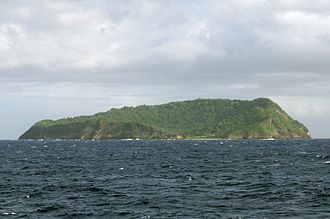Apolima is the smallest of the four inhabited islands of Samoa, in central South Pacific Ocean. It lies in the Apolima Strait, between the country's two largest islands: Upolu to the east, and Savai'i to the west.
 Apolima seen from the Upolu-Savai'i ferry | |
| Geography | |
|---|---|
| Location | Pacific Ocean |
| Coordinates | 13°49′26″S 172°09′04″W / 13.824°S 172.151°W |
| Area | 1 km2 (0.39 sq mi) |
| Coastline | 4.19 km (2.604 mi) |
| Administration | |
Samoa | |
| Demographics | |
| Population | 96 (2006) |

The island has one village settlement, Apolima Tai, with a population of 96.[1] The small settlement is situated in the interior's flat plateau, on the northern side.
Apolima is the rim of an extinct volcanic crater with a maximum height of 165 m. Its area is slightly less than one square kilometer. The only access to the island is by boat.
The tiny island lies 2.4 kilometres (1.5 mi) northwest off the westernmost edge of Upolu Island's fringing reef and 7 km (4 mi) southwest of the island of Savai'i. The island's shape is like an upturned bowl surrounded by steep cliffs. There is a broad opening to the sea on the northern side, which is the main entry point. Entry is only by boat.
There are two neighbouring islands in the strait, Manono Island, which has a small population, and the smaller, uninhabited islet of Nu'ulopa.
Apolima island is part of the political district of Aiga-i-le-Tai.[2]
In August 2022 the Ministry of Natural Resources and Environment began discussions with local residents about eradicating rats from the island to protect the local environment.[3]
Gallery
edit- Historical images of Apolima by Thomas Andrew (1855 - 1939)
-
Entrance to Apolima, left side
-
Apolima village, circa 1890 - 1910
-
Interior of the island, 1904
See also
editReferences
edit- ^ "Census 2016 Preliminary count" (PDF). Samoa Bureau of Statistics. Retrieved 2 August 2021.
- ^ "Samoa Territorial Constituencies Act 1963". Pacific Islands Legal Information Institute. Archived from the original on 5 June 2011. Retrieved 16 December 2009.
- ^ Fuimaono Lumepa Hald (28 August 2022). "Experts eye Apolima for rat eradication project". Samoa Observer. Retrieved 28 August 2022.